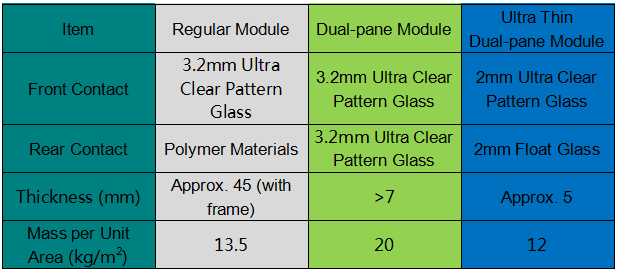What type of glass tempering furnace is the best choice for tempering ultra thin PV glass?
Answer:
Continuous Tempered Glass Machine of LandGlass will be your best choice for tempering ultra thin PV glass.
Why? First, Let’s see how the PV modules work.
1. PV glass is an important part of the solar cell (PV module).
2. PV modules have evolved from the adoption of regular components, dual-pane glass components, to the ultra thin dual-pane glass.

Note: BIPV stands for Building Integrated PV. PV stands for Photovoltaic
3. Structure of an ultra thin PV dual-pane module:
A PV cell consists of a Front Contact, crystalline silicon solar cell, and a Rear Contact.

The main difficulties in ultra thin glass tempering :
1.The surface stress of the glass does not meet the requirements for tempering
Because of its own heat conduction and heat exchange between its surface and the ambient environment, the temperature of the thinner glass will drop sharply due to the heat loss after the heating stops but before the quenching starts, making it harder to form appropriate temperature gradients through the thickness of the glass during quenching process. Thus it makes also the surface stress of the glass difficult to achieve fully or semi tempered status. While the ultra thin dual-pane cell adopts 2mm flat glass for front contact and rear contact, thermal tempering of these materials constitutes a big challenge. Thinner the glass is, the faster the surface cooling speed and higher the exit temperature it requires to maintain the power of the tempering blower within an acceptable range.
2. Surface quality does not meet the requirements
The surface quality and optical properties of the tempered glass cannot meet the requirements with unsatisfactory . The problem is usually manifested in several aspects: the glass requires higher heating temperature close or equal to the glass softening point temperature, causing roller marks on the surface; thin glass tends to get deformed when making stop in or passing through the furnace; the glass may be warped after tempering or leaves surface waves not removable; the glass may have obvious stress marks or other defects due to the uneven distribution of heating temperature in the chamber or cooling temperature on the air grid.
To overcome the shortfalls, it calls for advanced technologies in the transmitting, heating, cooling, and control processes. By adopting continuous loading and unloading methods and flexible production mode that may be adjusted easily in according to the size and features of the glass products, it is possible to improve dramatically the quality of the tempered glass while maximizing the productivity.
To this extent, the Continuous Glass Tempering Furnaces of LandGlass is your best choice for the tempering of ultra thin dual-pane PV glass.

